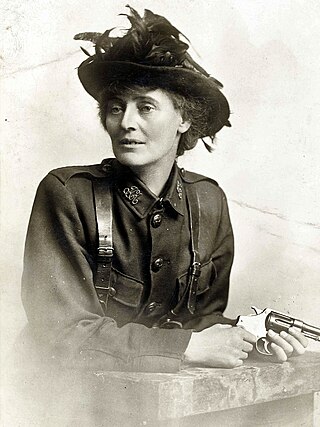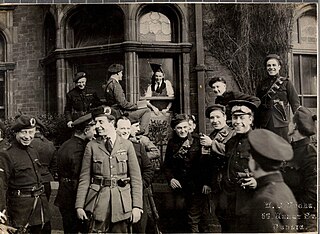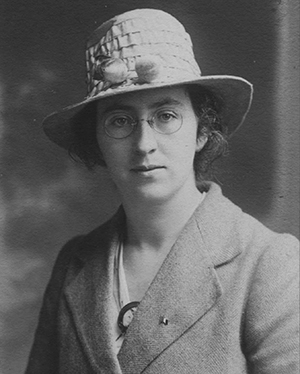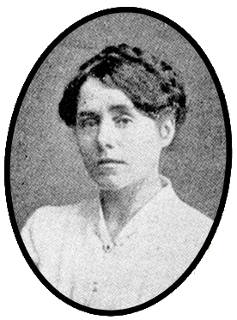Related Research Articles

The Easter Rising, also known as the Easter Rebellion, was an armed insurrection in Ireland during Easter Week in April 1916. The Rising was launched by Irish republicans against British rule in Ireland with the aim of establishing an independent Irish Republic while the United Kingdom was fighting the First World War. It was the most significant uprising in Ireland since the rebellion of 1798 and the first armed conflict of the Irish revolutionary period. Sixteen of the Rising's leaders were executed starting in May 1916. The nature of the executions, and subsequent political developments, ultimately contributed to an increase in popular support for Irish independence.

Constance Georgine Markievicz, also known as Countess Markievicz and Madame Markievicz, was an Irish politician, revolutionary, nationalist, suffragist, and socialist who was the first woman elected to the Parliament of the United Kingdom. She served as Member of Parliament (MP) for Dublin St Patrick's from 1918 to 1922. In the Irish Free State, she was elected Minister for Labour in the First Dáil, becoming the second female cabinet minister in Europe. She served as a Teachta Dála for the Dublin South constituency from 1921 to 1922 and 1923 to 1927.
Events in the year 1966 in Ireland.
Events from the year 1921 in Ireland.
Events from the year 1916 in Ireland.

"Come Out, Ye Black and Tans" is an Irish rebel song, written by Dominic Behan, which criticises and satirises pro-British Irishmen and the actions of the British army in its colonial wars. Its title refers to the Black and Tans, mainly former British Army soldiers, who reinforced the Royal Irish Constabulary (RIC) during the Irish War of Independence and committed many acts of violence and terror against the Irish population.

John Devoy was an Irish republican rebel and journalist who owned and edited The Gaelic American, a New York weekly newspaper, from 1903 to 1928.
Cumann na mBan, abbreviated C na mB, is an Irish republican women's paramilitary organisation formed in Dublin on 2 April 1914, merging with and dissolving Inghinidhe na hÉireann, and in 1916, it became an auxiliary of the Irish Volunteers. Although it was otherwise an independent organisation, its executive was subordinate to that of the Irish Volunteers, and later, the Irish Republican Army.
The Plough and the Stars is a four-act play by the Irish writer Seán O'Casey that was first performed on 8 February 1926 at the Abbey Theatre. It is set in Dublin and addresses the 1916 Easter Rising. The play's title references the Starry Plough flag which was used by the Irish Citizen Army.

Margaret Frances Skinnider was a revolutionary and feminist born in Coatbridge, Scotland. She fought during the 1916 Easter Rising in Dublin as a sniper, among other roles, and was the only woman wounded in the action. As a scout, she was praised for her bravery. Sadhbh Walshe in The New York Times refers to her as "the schoolteacher turned sniper".

Elizabeth O'Farrell was an Irish nurse, republican and member of Cumann na mBan, best known for delivering the surrender in the Easter Rising of 1916.
Maev Kennedy is an Irish journalist. She has worked as a staff news writer for The Irish Times, where she wrote the Dail (parliament) sketch, and for The Guardian. She has been a columnist for the Museums Journal and is a regular contributor to the Art Newspaper. At The Guardian, she edited the diary column, and was arts and heritage correspondent.

Máire Nic Shiubhlaigh was an Irish actress and republican activist. She started acting in her teens and appeared in the first Irish-language play performed in Ireland. She was a founder-member of the Abbey Theatre and was leading lady on its opening night in 1904, when she played the title role in W. B. Yeats's Cathleen Ni Houlihan. She later joined the Theatre of Ireland, which she helped to found.
Ria Mooney was an Irish stage and screen actress, artistic director of the Abbey Theatre (1948–1963) and director of the Gaiety School of Acting. She was the first female producer at the Abbey Theatre.
George J. Nesbitt was an Irish businessman and Free State senator from Kimmage, Dublin.

Julia Grenan was an Irish nationalist, republican, suffragette and socialist and member of Cumann na mBan, best known for being one of the three last women to leave the Headquarters during the Easter Rising of 1916.

Sean Connolly was an Irish republican, socialist and Abbey Theatre actor who took part in the Easter Rising. He was a captain in the Irish Citizen Army and was the first rebel to be killed during the Rising.

Louisa Nolan MM (1898–?) was an Irish woman recognized with the Military Medal by King George V for her bravery and humanitarian aid during the Easter Rising in Dublin, Ireland in 1916.
Mary McLoughlin (1901–1956) was one of the women who actively served in the 1916 Easter Rising. The younger sister of the famed "Boy Commandant General" Sean McLoughlin, at fifteen years old, she served as a dispatcher during the uprising, running messages between the various outposts held by the rebels. She is one of about 2000 participants of the Easter Rising who gave witness statements to document the events in the 1950s, after Ireland gained its independence.
Molly O'Reilly was an Irish republican and Socialist activist and soldier, taking part in the 1916 Irish Easter Rising with the Irish Citizen Army. Most notably, she unfurled the flag at Liberty Hall for the ICA during preparations for the rising.
References
- 1 2 3 4 5 6 7 8 9 10 11 12 13 14 15 16 17 18 Gallagher, Niav. "Bushell, Ellen Sarah ('Nellie')". Dictionary of Irish Biography . Retrieved 8 February 2024.
- ↑ Armstrong, Maggie (27 March 2016). "Stage: Here is your seat, Sir - and here are your guns". Irish Independent . Retrieved 8 February 2024.
- ↑ Gillis, Liz (17 May 2018). "The Silk Weaver, Usherette and Revolutionary". Culture Date with Dublin 8. Retrieved 8 February 2024.
- ↑ Mulkerns, Val. "Matinée at The Abbey". Sunday Miscellany . Retrieved 8 February 2024– via ValMulkerns.com.
- ↑ "Ellen Bushell, Easter Rising 1916 rebel and Abbey Theatre staff member. - Photographer unknown and Abbey Theatre". Google Arts & Culture . Retrieved 8 February 2024.
- ↑ "Abbey Theatre Nellie Bushell". RTÉ Archives . Retrieved 8 February 2024.